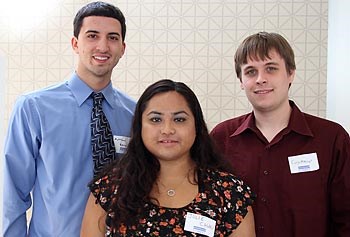Projects Designed to Purify Water, Assist People with Disabilities

From left, electrical engineering seniors Matthew Berardi, Julie Chau and J. Cory Miniter have designed an ultraviolet LED water-purification system for use by people living in rural India.
06/30/2013
By Edwin L. Aguirre
It’s a daily task we take for granted — we turn on the faucet and clean water comes out for drinking, cooking, cleaning, washing, bathing and watering the lawn. But for many people living in developing countries in Africa and Asia, having access to safe, clean drinking water can spell the difference between life and death.
“In India, which has a population of more than 1.2 billion, about 128 million lack safe water,” says electrical engineering (EE) senior Matthew Berardi. “About 1,600 people there die daily from diarrhea alone.”
With this in mind, Berardi teamed up with fellow EE seniors Julie Chau and J. Cory Miniter and recent graduate Magnim Lequessim to create a portable, low-cost water purifier designed to remove inorganic contaminants from untreated water and kill bacteria and any other pathogens present.
The group’s invention is just one of the innovative projects from 21 teams that were featured during the first annual “Capstone Project Showcase Day,” held in April at Cumnock Hall. The student-designed and built devices are part of the University’s unique Assistive Technology Program, which challenges seniors to come up with engineering solutions to solve real-world problems. This year’s Capstone Project Showcase Day highlighted inventions that ranged from electronic gadgets to help people with physical and developmental disabilities to relax and communicate with families and caregivers to a (https://www.uml.edu/News/stories/2013/BioBot.aspx) germ-detecting robot for use in hospitals, nursing homes and daycare centers.
Bringing Light, Clean Water to the World
Berardi and his team mates are collaborating with Dave Irvine-Halliday, a former EE professor at the University of Calgary. Halliday won a Rolex Award in 2002 for establishing Light Up the World (LUTW), a Canadian non-profit organization dedicated to providing affordable light-emitting diode (LED) illumination systems to people who have no electricity and are living in some of the poorest, most remote villages in the world.
The students’ water purifier, which features a two-stage filtration system and an ultraviolet LED pathogen-inactivation chamber, can process up to two gallons of raw water every day and can be powered using the LUTW’s solar panels.
“The device’s ultraviolet LEDs should be able to inactivate 99.99 percent of the harmful bacteria in untreated water,” notes Berardi.
Philip Seekell, a 2013 EE graduate, also created a water-purification system based on the ultraviolet LED design.
“Many rural water sources in India are contaminated with both biological and chemical pollutants, and more than 21 percent of the country’s diseases are water-borne,” says Seekell. “Only 21 percent of the population has access to traditional sanitation.”
He says his water-borne pathogen inactivation system can treat more than a gallon of raw water every 30 minutes.
“The prototype system costs about $2,000, but with large-volume manufacturing, the production cost can be reduced to less than $100 per unit,” says Seekell.
Helping People Help Themselves
The Capstone Project Showcase Day also featured two teams that developed robotic arms to assist physically and mentally challenged individuals who cannot feed themselves.
“Eating is a vital part of everyday life,” says Philip Colangelo, a graduate student in computer engineering. “However, people who face debilitating conditions, such as loss of motor control, paralysis, amputation and cognitive disabilities, have to rely on others. My robotic feeding arm offers its user a degree of independence and frees up the healthcare staff for other tasks.”
Colangelo incorporated machine vision into his arm design so it can scoop up food from a bowl or plate and then deliver it to the operator’s mouth even if the person’s head moves during the process. He says the arm is simple and easy to use and folds into a compact size for easy storage. The prototype unit cost about $800 to build.
“Similar concept robotic designs can range in price from $3,000 to $10,000,” notes Colangelo.
His feeding arm won first place in the “Innovative Technology” category at this year’s first UMass Lowell DifferenceMaker Idea Challenge. The award consisted of $3,500 in cash prize.
Recent EE graduates Shaun Peters, Diego Villareal and Pablo Faria, together with senior Evan Griffith, created a customized feeding arm for their client — Hingham resident Randy Pipkin — who suffers from amyotrophic lateral sclerosis (ALS), a neurodegenerative disorder also known as Lou Gehrig’s disease.
“The arm is simple to setup and easy to operate,” says Peters.
The arm works in tandem with a motorized Lazy Susan-style tray that can accommodate up to three plates, bowls or cups. Pipkin says he now uses the arm to eat yogurt, oatmeal and grits.
“It brings us a lot of joy to see him use it and enjoy a sense of freedom,” says Peters.
